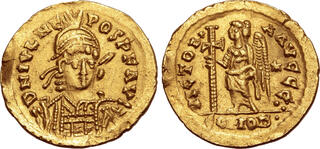| Roma Numismatics Ltd > Auction XXX | Auction date: 21 March 2024 |
| Lot number: 549 Price realized: 15,000 GBP (Approx. 19,002 USD / 17,495 EUR) Note: Prices do not include buyer's fees. | Show similar lots on CoinArchives Find similar lots in upcoming auctions on |
| Lot description: Julius Nepos AV Solidus. Rome, 19 June AD 474 - 28 August AD 475. D N IVL NEPOS P F AVG, helmeted, pearl-diademed and cuirassed bust facing, holding spear and shield decorated with horseman and fallen enemy motif / VICTORIA AVGGG:, Victory standing facing, head to left, holding long jewelled cross; star in right field, COMOB• in exergue. RIC X -; Depeyrot 77/1; DOC -; Lacam -. 4.26g, 20mm, 6h. Extremely Fine. Extremely Rare; only one example cited by Depeyrot, that held by the Vatican museum, thus seemingly the only example in private hands. Ex Roma Numismatics Ltd., Auction XXIII, 24 March 2022, lot 1141 (hammer: GBP 10,000). While many historians consider Romulus Augustus to have been the last Roman emperor in the West, Julius Nepos' claim to this dubious honour is no less strong. Elevated to the position of Augustus by the Eastern emperor Leo I in AD 474 in order to replace the usurper Glycerius, who had been raised to the vacant throne by the Burgundian Magister militum Gundobad, Julius Nepos was married to the niece of Leo I and was also the nephew of the sovereign governor of Dalmatia, Marcellinus, hence his agnomen of nepos - "nephew". In January, before Nepos could move against Glycerius, Leo I died and was succeeded by his grandson, the young Leo II, who chose his own father Zeno as co-emperor. While little is known of Glycerius, according to Ennodius, the emperor "made many measures for the public good", and seems to have tried his best to remain on good terms with the East Roman Empire, making overtures for reconciliation and abstaining from choosing a second Consul in order to allow Leo II to be sole Consul for the year 474. Nonetheless, under Roman Law Glycerius' elevation was illegal, as the Eastern emperor had the right to choose his co-emperor, and Zeno maintained the official position of Constantinople to deny recognition to Glycerius. Therefore, in the spring of 474, when the ports which had been closed for the winter reopened, Nepos made to cross the Adriatic Sea to depose Glycerius, who may have temporarily left the imperial court at Ravenna and relocated to Rome to resist the invasion, where he minted an extremely rare silver issue claiming himself as Augustus along with Leo II and Zeno. However, by June Nepos had entered Ravenna and deposed Glycerius without bloodshed, perhaps because he had failed to receive the support of the Roman Senate and Gallo-Roman aristocracy, or because his Magister militum Gundobad was absent from Italy either to raise more troops in Gaul, or to receive the legacy of his father Gundioc as King of the Burgundians. In any case, Nepos spared Glycerius' life, an act of clemency possibly prompted by Glycerius' apparently benevolent rule and the respect he had shown to the Eastern emperors throughout his short reign, and he was sent to lead a life of religious service as Bishop of Salona. Nepos' own reign was hardly longer than that that of his predecessor; in August of 475 his Magister militum Orestes took control of the government at Ravenna, forcing Nepos to flee by ship back to Dalmatia. Orestes then proceeded to enthrone his teenage son as the new emperor in the West, under the regnal name Romulus Augustus. Though deposed, Nepos continued to be recognised as the de jure Emperor of the West until his death in 480, whereupon Zeno formally abolished the division of the Empire, ending the last legal claim to the throne of the West Roman Empire. Estimate: 7500 GBP |  |


